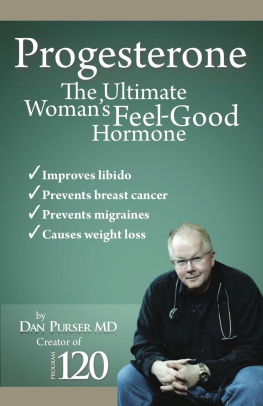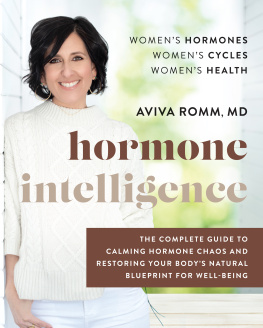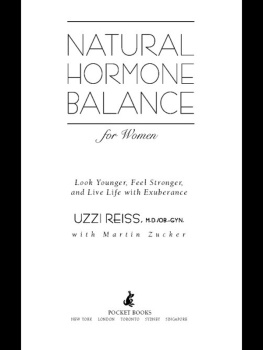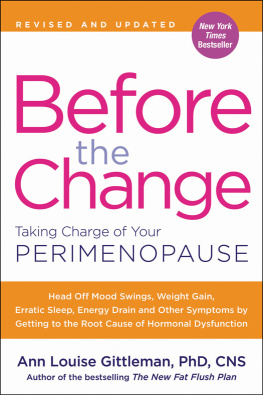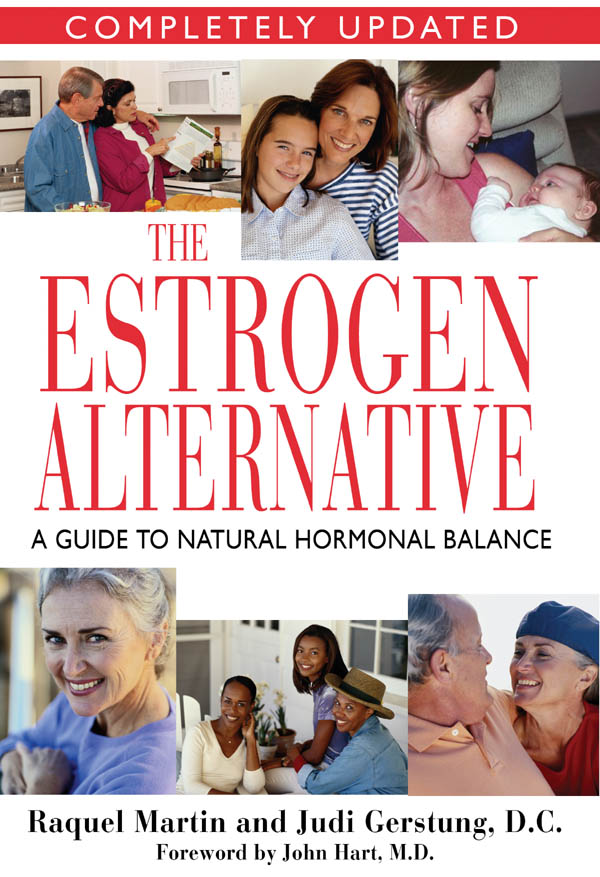THE
ESTROGEN
ALTERNATIVE
A GUIDE TO NATURAL
HORMONAL BALANCE
Fourth Edition
Raquel Martin
and Judi Gerstung, D.C.

Healing Arts Press
One Park Street
Rochester, Vermont 05767
www.InnerTraditions.com
Healing Arts Press is a division of Inner Traditions International
Copyright 1997, 2000, 2005 by Raquel Martin
First edition 1997
Fourth edition 2005
All rights reserved. No part of this book may be reproduced or utilized in any form or by any means, electronic or mechanical, including photocopying, recording, or by any information storage and retrieval system, without permission in writing from the publisher.
Note to the reader: This book is intended as an informational guide. The remedies, approaches, and techniques described herein are meant to supplement, and not to be a substitute for, professional medical care or treatment. They should not be used to treat a serious ailment without prior consultation with a qualified health care professional.
The Library of Congress has catalogued a previous edition of this title as follows:
Martin, Raquel.
The estrogen alternative : natural hormone therapy with botanical progesterone / Raquel Martin, with Judi Gerstung.
p. cm.
Includes bibliographical references and index.
print ISBN 0-89281-893-X
eISBN 978-1-59477-619-9
1. ProgesteroneTherapeutic use. 2. Generative organs, FemaleDiseasesAlternative treatment. 3. MenopauseComplicationsAlternative treatment. 4. Plant hormonesTherapeutic use. 5. Generative organs, FemaleDiseasesHormone therapy. I. Gerstung, Judi. II. Title.
RG129.P66 M373 2000
618.106dc21
99-089914
ISBN of fourth edition: 978-1-59477-033-3
Printed and bound in the United States at Lake Book Manufacturing, Inc.
10 9 8 7 6 5 4 3 2 1
Text design and layout by Kristin Camp Sperber
This book was typeset in Adobe Caslon, with Bauer Bodoni and Gill Sans as display typefaces
Contents
PART I
Natural Hormone Replacement from Gods Garden
PART II
Opening Up a New World of Hope and Healing
PART III
Making Assertive Lifestyle Changes
Foreword to the Third Edition
Raquel Martin and her coauthor, Dr. Judi Gerstung, have performed a tremendous service to the women of America by writing The Estrogen Alternative. I believe all women will greatly benefit from reading this well-written and resource-laden book. I am sure many will identify with Raquels experiences and frustration as she wanders through the maze of traditional medical therapy seeking relief for her menopausal symptoms.
It has been my observation that when women are presented with the information in this book, it makes sense to them and provides encouragement for change. As the authors point out, not only are the hot flashes, irregular menses, and emotional upsets relieved by natural hormone therapy, but also such conditions as insomnia, weight gain, dry skin, fatigue, osteoporosis, thinning hair, and depression. Unfortunately, the symptoms on this list, often wrongly attributed to estrogen deficiency rather than estrogen dominance, are treated by allopathic medicine with even more estrogen. This can lead to worsening of symptoms, increased bleeding, or the often unnecessary hysterectomy.
Not recognizing that many of these problems could be eliminated or controlled by Natures counterbalance to estrogen, natural progesterone, the physician may deal with the other notable symptoms created by estrogen dominance as separate maladies, resulting in individual testing and treatment for each complaint. Depression is treated as a Prozac deficiency, water retention with a diuretic, weight gain with appetite suppressants, whereas the solution can be as simple as counteracting estrogen overload with what the patient is no longer able to produce on her ownnamely, progesterone.
Women today need a book like this to understand what is happening to their bodies during pre-, peri-, and postmenopause and to recognize the symptoms of estrogen dominance and anovulation that are so prevalent. It is a tremendous resource to any practitioner such as myself to recommend to this patients. It is a valuable teaching tool as I try to educate my patients about the many hormonal changes that are taking place. With this knowledge, women can make informed choices, not only about natural hormone therapy but also about exercise, diet, and vitamin and mineral supplementation. The Estrogen Alternative fulfills this need. Otherwise, my patients are at the mercy of the pharmaceutical industry and their dollars that are pumped into womens magazines and other advertising media.
John T. Hart, M.D.
Foreword to the Second Edition
The 1990s have brought about considerable changes in health care in this country. Many of these changes result from the emergence of managed care organizations in an attempt to reduce medical costs. This approach, unfortunately, has brought with it limitations and restrictions on health care delivery. Many consumers are now turning to more user-friendly complementary and alternative care in which individuals take an active part in the decisions necessary to maintain optimum health.
Expanding knowledge of the usefulness of such complementary care is supported by the Dietary Supplement Health and Education Act of 1994. A major aspect of this includes the greater use of plant chemicals (phytochemicals) as dietary supplements or medicinals, which in many cases may replace synthetic pharmaceuticals.
As women become more and more involved in decisions about hormone replacement therapy (HRT), The Estrogen Alternative serves a vital need. It is very timely and addresses this increasingly complex problem. The dilemma of HRT today stems largely from the many inconclusive and contradictory studies published by traditional medical institutions.
The woman who chooses to be an active participant in decisions regarding hormone therapy must first heed the authors reminder that we still have a lot to learn. With that in mind, they have presented an extensive amount of information on HRT, with emphasis on the use of natural progesterone. The decisions a woman makes must include consideration of risk versus benefit, a vital factor in all health care choices. Its not an easy task, and unfortunately, the focus of most scientific studies has been only synthetic preparations. This book addresses the many aspects of HRT, whether natural or synthetic, that we need to consider. On one hand, benefits include a reduction in both osteoporosis (progesterone decreases the risk of bone fractures and vertebral body collapse) and vascular disease (it also decreases the risk of heart attacks and stroke). On the other hand is increased risk of breast and endometrial cancer with traditional HRT. A womans quality of life, as well as her longevity, are influenced by her decisions about hormone therapy. Yet much of the information that reaches the general public provides inconclusive data on which to base proper decisions.
The Estrogen Alternative examines the benefits of natural progesterone therapy for women of all ages. The authors shared experiences make it even more appealing. They provide educational support for women who wish to participate in decisions about their own care. They also present a challenge to the physicians who, it is hoped, will become more receptive to patients considering a more natural approach.


